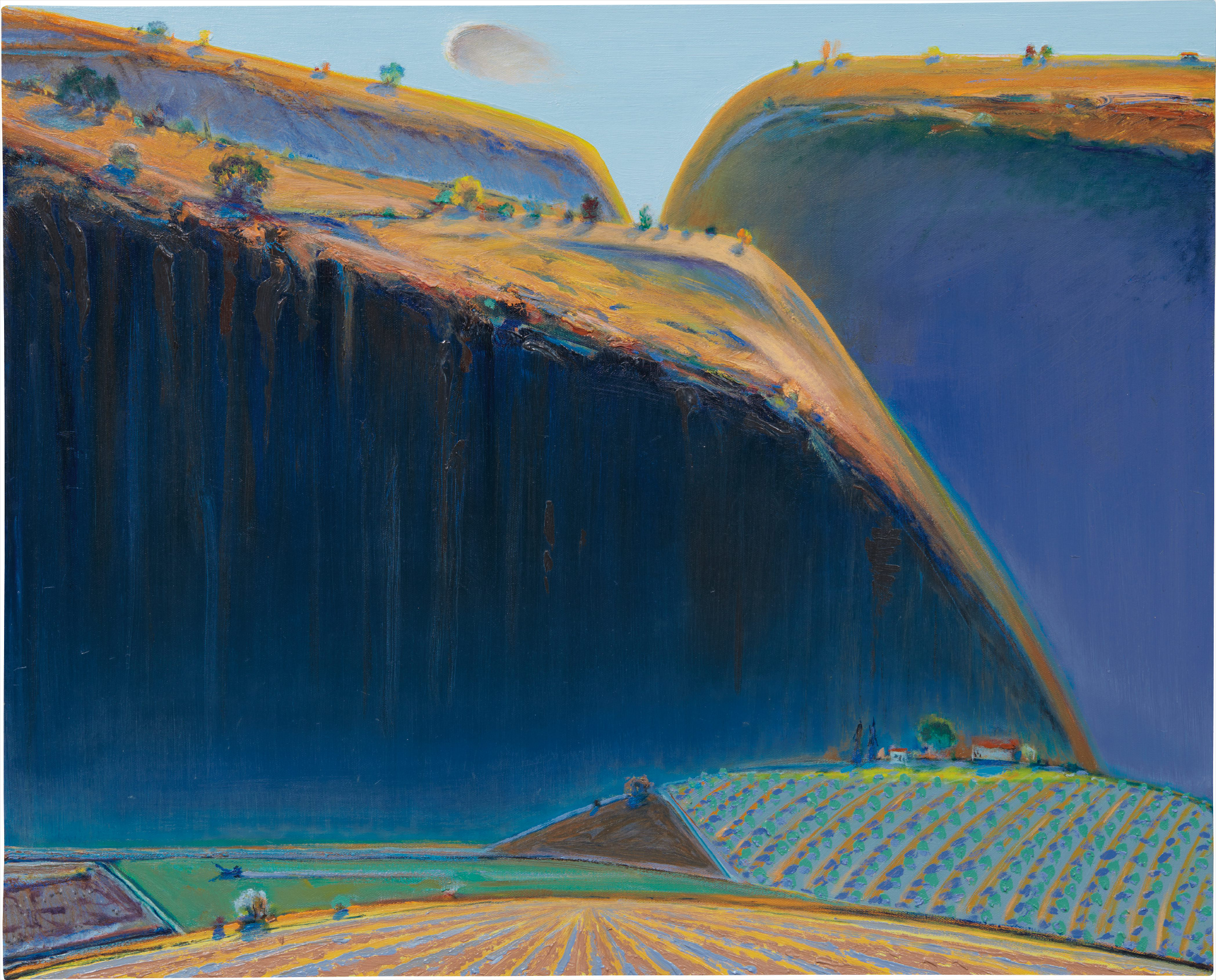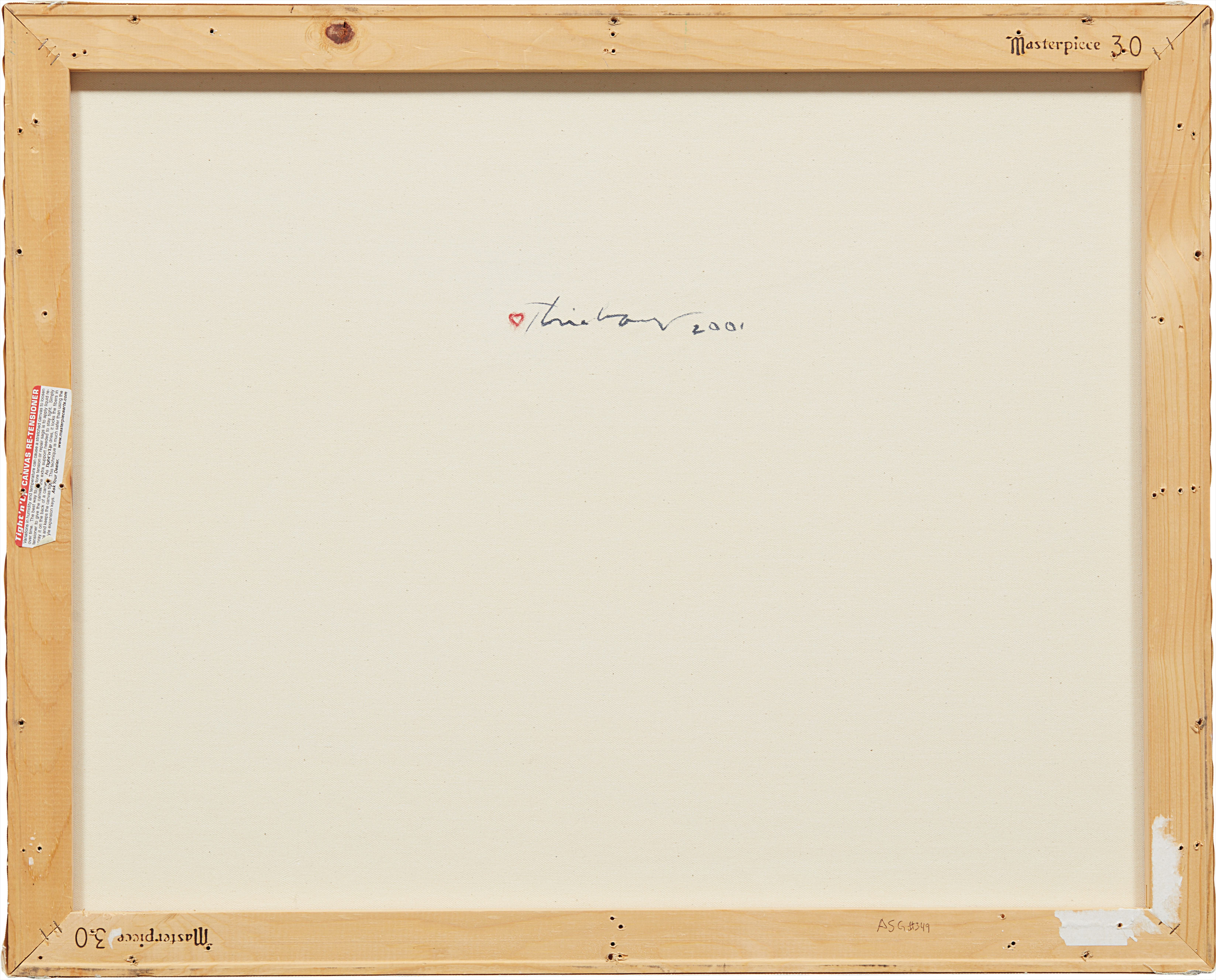



27
Wayne Thiebaud
Valley Ranch
signed and dated "Thiebaud 2001" on the reverse
oil on canvas
24 x 30 in. (61 x 76.2 cm.)
Painted in 2001.
Full-Cataloguing
"These paintings exhibit a complexity and, above all, an old-masterish cultivation of detail, completely without ironical intent, that has not been observed in art since the drip paintings of [Jackson] Pollock or the glorious late Ateliers of [Georges] Braque."
– Richard Wollheim
Evidencing the fresh rigor of Wayne Thiebaud’s late practice, Valley Ranch, 2001, draws the viewer into an exquisitely painted landscape of the artist’s Northern California environs. Anticipating the soaring vistas of Canyon Mountains, 2011-2012, San Francisco Museum of Art, here in Valley Ranch, majestic bluffs dramatically engulf the picture plane, giving way to a pastoral, rural scene. The signs of human presence that dot the foothills and the mountain ridge are dwarfed by the majesty of the natural phenomena. Built up through luscious layers of paint, the vista glistens in an unexpected kaleidoscope of violet blue, vibrant yellow and pastel hues that coalesces to bath the scene in warm and intense light. In its saturated color palette and meticulous painterly technique, Valley Ranch represents a powerful continuation of the artist’s enduring fascination with landscape in his distinct visual language.
Executed in 2001, Valley Ranch speaks to Thiebaud’s reinvigorated preoccupation with a subject that had figured prominently early in his career. Based in Sacramento, Thiebaud conceived his first landscapes in the 1960s and dedicated himself intensely to this subject matter during the 1970s, creating California-inspired landscape and cityscapes characterized by an exuberant experimentation with perspective and saturated color palette. Paintings such as the present one demonstrate a distinct formal departure from these early works. As Karen Wilken highlighted, these “recent landscapes…with their towering heights and vast, unfolding planes, are more audacious, spatially, than his earlier investigations of similar motifs” (Karen Wilken, “An American Master”, Wayne Thiebaud, New York, 2015, p. 16).
Developing out of Thiebaud’s celebrated Sacramento River Delta series from the late 1990s, Valley Ranch is representative of the artist’s interest in the imagery of mountains, canyons and cliffs – its title referring to an area north of Sacramento, close to Lake Tahoe. Despite the specific geographical reference, however, the present work conveys a certain “transcendent Americanness…a kind of Everyplace America” that is characteristic of Thiebaud’s oeuvre (Susan Larsen, “Oral history interview with Wayne Thiebaud”, Smithsonian Archive of American Art, 2001, online). Transcending specificities of place, Valley Ranch puts forward an idyllic image of nature that appears to have existed long before the turn of the 21st century – alluding to the artist’s own adolescent memories of spending his summers at his grandfather’s Californian farm and living on a ranch in Utah for a few years in the 1920s. With traces of human presence confined to the marginal field, the scene moreover reveals a sense of inwardness, enigma and stillness that recalls Edward Hopper’s intimate investigations of modern American life.
Playing with the mythology of the American West as a land of unlimited promise and potential, Thiebaud presents us with a wholly imagined landscape. As Thiebaud explained of his distinctive process, “with me, it’s about remembrance — sketching certain types of reflected patterns, different kinds of lighting, then conjuring it up with your memory and imagination” (Wayne Thiebaud, quoted in Patricia Leigh Brown, “Sweet Home California”, The New York Times, September 21, 2010, online). Rendered with almost psychedelic colors evocative of Pierre Bonnard, Thiebaud’s pictorial liberties give rise to a vivid tension between illusionism and the materiality of painting. As art historian David Anfam indeed highlighted of the present work, “sun-glow tinted as California’s Palomino grass is, it never attains the preternatural pitch of the highlights in Valley Ranch…Thiebaud’s hills and ridges, although rooted in the geography around the Central Valley and the Sierra Nevada, have an exaggerated precipitousness reminiscent of [Clyfford] Still’s abstractions” (David Anfam, Wayne Thiebaud, exh. cat., Faggionato Fine Art, London, 2009, p. 7). Through his mastery of the medium of painting, Thiebaud succeeds in producing a scene which is at once familiar and surreal, ethereal and grounded – prompting us to reconsider the differences between the perceivable world and the invented.
– Richard Wollheim
Evidencing the fresh rigor of Wayne Thiebaud’s late practice, Valley Ranch, 2001, draws the viewer into an exquisitely painted landscape of the artist’s Northern California environs. Anticipating the soaring vistas of Canyon Mountains, 2011-2012, San Francisco Museum of Art, here in Valley Ranch, majestic bluffs dramatically engulf the picture plane, giving way to a pastoral, rural scene. The signs of human presence that dot the foothills and the mountain ridge are dwarfed by the majesty of the natural phenomena. Built up through luscious layers of paint, the vista glistens in an unexpected kaleidoscope of violet blue, vibrant yellow and pastel hues that coalesces to bath the scene in warm and intense light. In its saturated color palette and meticulous painterly technique, Valley Ranch represents a powerful continuation of the artist’s enduring fascination with landscape in his distinct visual language.
Executed in 2001, Valley Ranch speaks to Thiebaud’s reinvigorated preoccupation with a subject that had figured prominently early in his career. Based in Sacramento, Thiebaud conceived his first landscapes in the 1960s and dedicated himself intensely to this subject matter during the 1970s, creating California-inspired landscape and cityscapes characterized by an exuberant experimentation with perspective and saturated color palette. Paintings such as the present one demonstrate a distinct formal departure from these early works. As Karen Wilken highlighted, these “recent landscapes…with their towering heights and vast, unfolding planes, are more audacious, spatially, than his earlier investigations of similar motifs” (Karen Wilken, “An American Master”, Wayne Thiebaud, New York, 2015, p. 16).
Developing out of Thiebaud’s celebrated Sacramento River Delta series from the late 1990s, Valley Ranch is representative of the artist’s interest in the imagery of mountains, canyons and cliffs – its title referring to an area north of Sacramento, close to Lake Tahoe. Despite the specific geographical reference, however, the present work conveys a certain “transcendent Americanness…a kind of Everyplace America” that is characteristic of Thiebaud’s oeuvre (Susan Larsen, “Oral history interview with Wayne Thiebaud”, Smithsonian Archive of American Art, 2001, online). Transcending specificities of place, Valley Ranch puts forward an idyllic image of nature that appears to have existed long before the turn of the 21st century – alluding to the artist’s own adolescent memories of spending his summers at his grandfather’s Californian farm and living on a ranch in Utah for a few years in the 1920s. With traces of human presence confined to the marginal field, the scene moreover reveals a sense of inwardness, enigma and stillness that recalls Edward Hopper’s intimate investigations of modern American life.
Playing with the mythology of the American West as a land of unlimited promise and potential, Thiebaud presents us with a wholly imagined landscape. As Thiebaud explained of his distinctive process, “with me, it’s about remembrance — sketching certain types of reflected patterns, different kinds of lighting, then conjuring it up with your memory and imagination” (Wayne Thiebaud, quoted in Patricia Leigh Brown, “Sweet Home California”, The New York Times, September 21, 2010, online). Rendered with almost psychedelic colors evocative of Pierre Bonnard, Thiebaud’s pictorial liberties give rise to a vivid tension between illusionism and the materiality of painting. As art historian David Anfam indeed highlighted of the present work, “sun-glow tinted as California’s Palomino grass is, it never attains the preternatural pitch of the highlights in Valley Ranch…Thiebaud’s hills and ridges, although rooted in the geography around the Central Valley and the Sierra Nevada, have an exaggerated precipitousness reminiscent of [Clyfford] Still’s abstractions” (David Anfam, Wayne Thiebaud, exh. cat., Faggionato Fine Art, London, 2009, p. 7). Through his mastery of the medium of painting, Thiebaud succeeds in producing a scene which is at once familiar and surreal, ethereal and grounded – prompting us to reconsider the differences between the perceivable world and the invented.